Opel Corsa Engine: Performance and Dependability for Your Car
Opel Corsa Engine: Performance and Dependability for Your Car
Blog Article
Checking Out the Inner Operation of a Compact Lorry's Engine System
As chauffeurs, we often take for approved the intricate procedures that take place within the confines of our lorry's engine system. In this exploration of a small vehicle's engine system, we will untangle the inner functions of this mechanical harmony, shedding light on the secrets that drive us onward on our daily trips.
Burning Process Introduction
The burning process in a small lorry's engine system is an important mechanism that effectively transforms gas into energy to power the lorry. This process occurs within the burning chamber of the engine, where gas and air mix, ignite, and produce controlled surges. The burning process contains four primary phases: consumption, power, compression, and exhaust.
During the consumption stage, the piston relocates downward, attracting a mixture of air and gas right into the combustion chamber. The following stage, compression, involves the piston relocating up, compressing the air-fuel combination to enhance its effectiveness. Consequently, in the power phase, the stimulate plug stirs up the compressed combination, leading to a quick growth of gases that compels the piston back down. This descending motion creates the power needed to drive the lorry. In the exhaust stage, the scorched gases are removed from the burning chamber through the exhaust shutoff, preparing the chamber for the following cycle. This cyclic burning procedure is fundamental to the operation of a small lorry's engine system, making sure reliable power conversion for propulsion.
Piston and Cyndrical Tube Interaction

The piston's exact fit within the cyndrical tube is necessary for keeping optimum compression and protecting against power loss throughout burning. Limited clearances between the piston and cylinder walls guarantee effective sealing, allowing the piston to move efficiently without permitting gases to leakage past. Correct lubrication is likewise crucial to minimize friction and wear between these parts, boosting long life and efficiency.
Moreover, the style and materials used in making the piston and cyndrical tube effect engine effectiveness and sturdiness. Modern engines commonly utilize lightweight yet sturdy products like aluminum alloys for pistons and cylinder linings to minimize inertia and improve thermal efficiency. Overall, the unified interaction between the piston and cyndrical tube is essential to the engine's functionality and total efficiency.
Fuel Injection System Capability
Fuel shot systems in portable car engines play an important function in precisely supplying gas to the combustion chamber for efficient and controlled ignition. The gas injection system functions by infusing fuel right into the combustion chamber at the optimum moment throughout the engine's operation (opel corsa engine). This specific timing guarantees that the gas mixes equally with the air for appropriate burning, resulting in boosted fuel effectiveness and reduced discharges
There are primarily two sorts of fuel injection systems utilized in portable car engines: port gas injection (PFI) and direct gas shot (DFI) PFI systems inject gas right into the intake port before the consumption valve, while DFI systems inject fuel straight right into the combustion chamber. Both systems have their advantages, with DFI providing better fuel atomization and PFI offering an extra cost-effective service.
Recognizing Engine Cooling Systems
Reliable procedure of a small car's engine relies heavily on the her comment is here performance of its cooling systems. The cooling system in a compact lorry commonly is composed of a number of components functioning with each other to control the engine temperature. Understanding these engine air conditioning systems is vital for preserving the performance and long life of a portable vehicle's engine system.

Exhaust System Components Explained
The optimal performance of a compact automobile's engine air conditioning systems depends on a corresponding system recognized as the exhaust system, which comprises different important parts for guaranteeing reliable emissions and engine efficiency. The exhaust manifold accumulates exhaust gases from the engine's routes and cylinders them to the catalytic converter.
One critical component of the exhaust system is the oxygen sensing unit, which checks the oxygen levels in the Website exhaust gases to assist manage fuel usage and make certain optimal engine performance. opel corsa engine. In addition, the resonator might be present in some exhaust systems to minimize sound degrees. In general, the exhaust system plays a crucial duty in maintaining engine effectiveness, minimizing harmful emissions, and making sure a quieter driving experience for portable lorry owners

Verdict
Finally, the small vehicle's engine system is a complicated mix of parts that work together to help with the burning procedure, transform fuel into power, and expel waste gases. Comprehending the internal workings of the engine system, including the piston and cylinder interaction, fuel injection system, engine cooling systems, and exhaust system elements, is vital for keeping optimum efficiency and performance of the vehicle.
The combustion process in a compact vehicle's engine system is a crucial system that effectively converts fuel right into power to power the vehicle.Fuel injection systems in small car engines play an essential duty in specifically delivering gas to the combustion chamber for controlled and efficient ignition.There are largely 2 kinds of gas injection systems used in compact lorry engines: port gas injection (PFI) and direct gas shot (DFI) Comprehending these engine cooling mechanisms is vital for maintaining the efficiency and durability of a small vehicle's engine system.
The optimum performance of a small car's engine cooling devices depends on a corresponding system known as the exhaust system, which right here consists of numerous necessary elements for guaranteeing reliable discharges and engine performance.
Report this page